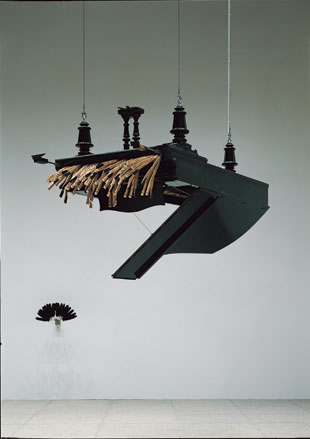
December 3, 2009
Rebecca Horn
The edgy contemporary artist unfurls her sad wings of destiny at the MOT
By Metropolis
Originally published on metropolis.co.jp on December 2009

Concert for Anarchy, 1990, installation
Photo by Attilio Maranzano ©2009: Rebecca Horn
As it stands now, Europe is a dying civilization. If demographic trends hold, within about 50 years it will become an Islamic continent or, possibly, go through a bloodbath approximating the horrors of Bosnia or the Third Reich. Of course, much can be done—and hopefully will be—to avert such extremes, but this seems to be the current trajectory.
As an art writer, this is not the sort of thing I normally worry about. I’m much more concerned about the latest auction prices at Sotheby’s or whether a particular shade of pink harmonizes with a certain color scheme. But “Rebellion in Silence: Dialogue Between Raven and Whale,” a major retrospective of contemporary German artist Rebecca Horn at the Museum of Contemporary Art (MOT), seems to have the power to unwittingly provoke such dark musings and forebodings.
Maybe it was The Raven’s Twin (1997), an eerie moving installation made of two sets of black feathers that slowly genuflect to each other, like two crows deciding which is to have first pickings of a carcass, that sounded the initial note of doom. Or possibly it was the discordance that suddenly erupted from Concert for Anarchy (1990), a piano suspended upside-down from the ceiling, which spewed forth its guts every 15 minutes before slowly retracting them.
These works and others showcase Horn’s trademark mechanical ingenuity. Occasionally, as with the flapping, butterfly-like suitcase in one of the many videos on display, the result can be humorous, but more often than not the effect is darkly sinister. Knuggle Dome for James Joyce (2004) presents two sets of four knives—one spelling out “love” and the other “hate.” Slowly moving backwards and forwards in endless animosity, they imply moral equivalence between the two emotions, and therefore nihilism.

Knuggle Dome for James Joyce, 2004, installation
Photo by Gunter Lepkowski ©2009: Rebecca Horn
The precision engineering of these pieces, along with a certain over-earnestness, also serves to remind us of the artist’s Germanic origins and all that this implies. She was actually born in Hitler’s Germany in 1944, a fact that, combined with other aspects of her art, is capable of setting off certain troubling trains of thought.
Horn’s work also shows the default feminism found in much of Western contemporary art. The Seventy-Seven Branches of Destiny (1993) places knives and brushes on slowly moving metal rods, so that the blades constantly penetrate the brushes, which are meant to symbolize vaginas. This is an allusion to the feminist concept of sexual relations as a “violation of the female body.”
Along the same lines, many of Horn’s body extension pieces—most notably, the phallic Unicorn (1970), an early performance work captured on film—have a clear feminist or even Freudian agenda. By attaching feathers, wings, trunks, cones and poles to her body, Horn seeks to empower herself and other women. But it is not quite as simple as that. These pieces, like the iconic pencil mask used in the video installation Performances 2 (1973), sometimes bear an unfortunate resemblance to bondage gear, thereby evoking ideas of female submission.

Light Imprisoned in the Belly of the Whale, 2002, installation
Photo by C.B. Liddell ©2009: Rebecca Horn
This leads us to the paradox of feminism: that it is ultimately self defeating. The enhanced position that women enjoy in European societies is a major civic achievement, but at the same time liberated European womanhood is now producing far fewer children than is necessary to replace population, leaving the door wide open to continued mass immigration and the high birthrates of people from less sexually egalitarian cultures.
Because Horn is a “progressive” contemporary artist whose career has been furthered by Europe’s socialized and therefore left-leaning public art institutions, these are hardly the kinds of issues that she would address directly in her work or would even want to. But, time and again, the poetic nature of her creations unconsciously unleashes troubling contradictions and ominous premonitions of the future.
Museum of Contemporary Art, Tokyo
Rebecca Horn. Rebellion in Silence: Dialogue Between Raven and Whale. Various media. Until Feb 14, free (elem and under)/¥600 (MS, HS)/¥800 (65 and over)/¥900 (univ)/¥1,200 (general). 4-1-1 Miyoshi, Koto-ku. Open Tue-Sun 10am-8pm, closed Mon. Nearest stn: Kiyosumi-Shirakawa. www.mot-art-museum.jp






